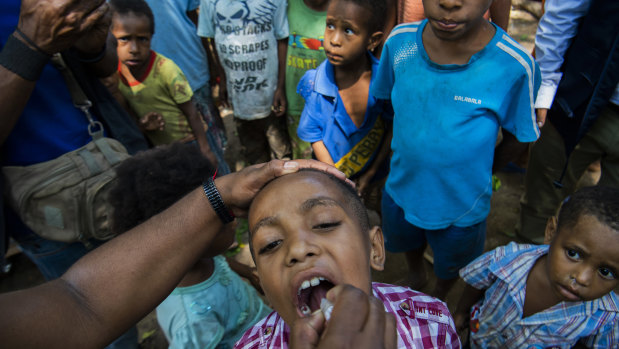This was published 4 years ago
Opinion
Guns v giving: the trend that says everything about our priorities
Matt Wade
Senior economics writerIt’s a trend that gets scant attention but says a lot about our national priorities: Australia’s spending on defence and overseas aid is rapidly diverging.
We’ve always spent more on arms than aid, of course.

A child in Papua New Guinea receives a polio vaccine. The coronavirus outbreak threatens to reverse decades of progress in alleviating poverty.Credit: Louise Kennerley
But the amount allocated to the military now eclipses foreign assistance by more than 10 to one, the biggest gap on record.
And that disparity is set to widen dramatically in the decade ahead.
A strategic defence update released by Prime Minister Scott Morrison last month said total defence funding will rise from $42 billion this financial year to $74 billion in 2029-30.
Analysis by Australian National University economist, professor Stephen Howes, shows that will lift defence spending to 2.6 per cent of gross domestic product, the highest proportion since the closing stages of the Vietnam War 50 years ago.
Foreign aid’s share, on the other hand, will shrink to just 0.17 per cent of GDP by decade’s end.
Military spending has been a top priority for the Abbott, Turnbull and Morrison governments. But it’s difficult to find an area of government expenditure that’s fared worse than foreign aid in recent years.
It was cut for a sixth year in a row in the last federal budget and is now almost a third lower than it was in 2013-14 after adjusting for inflation.
In the mid-1970s more than 2 per cent of the federal budget was allocated to overseas aid but that will fall to just 0.78 per cent this financial year.
For every $100 of national income Australia now contributes just 20 cents to overseas aid - the least generous share on record.
We’ve tumbled down the international generosity league table as a result.
Back in 1995, as the economy recovered from the last deep recession, we were ranked the world’s 9th most generous aid donor by the share of gross national income devoted to overseas development assistance. But Australia had slumped to 19th place by 2017 according to the Australian Aid Tracker website created by ANU’s Development Policy Centre.
Professor Howes says that for more than half a century - from the early 1960s to the mid-2010s - the ratio of defence-to-aid spending moved within a relatively narrow band between about 5 and 8.
But the Morrison government has changed that - on current trends defence funding will be 16 times more than foreign aid by the end of the decade.
“No Australian government in the last 60 years has ever before given defence such priority relative to foreign aid,” says Howes.
“It’s putting all its eggs in the defence basket while de-funding aid.”
So is this less generous, more militaristic posture the right way to go?
Morrison has warned Australia must prepare for a post-COVID world “that is more dangerous, and that is more disorderly”.
While launching the strategic defence update last month he drew parallels between this year’s coronavirus-induced turmoil and the economic upheaval and conflict of the 1930s and 1940s.
In a speech to an international security forum on Wednesday Morrison described the strategic defence update as “a major strengthening of our force posture” and claimed Australia was “building the capability and potency of our defence force, sharpening our focus on our immediate region, and increasing our capabilities to deter actions against our interests.”
But the same forces making the world more dangerous are also making it much poorer.
Economic turmoil triggered by the pandemic threatens to erode decades of progress in Australia’s immediate region.
The number of people living in extreme poverty on Australia’s doorstep is set to skyrocket.
ANU development economist, Christopher Hoy, estimates that a 10 per cent decline in income per person in Indonesia will increase the rate of extreme poverty by 50 per cent. And that scenario may prove to be conservative considering the scale of the economic shock.
Many others nearby face similar economic challenges - the Lowy Institute’s Jonathan Pryke points out that 17 of Australia’s closest 20 neighbours are recipients of foreign aid.
The Morrison government recently announced it would “redirect” about $280 million of the existing foreign aid budget to assist nations in the Pacific and south-east Asia cope with the coronavirus crisis.
Foreign Minister Marise Payne called this “an unprecedented pivot of our development program”.
But much more will be required.
“It’s in our interests as a global citizen to be funding efforts to promote development,” says Howes.
“But it’s going to be impossible for us to play that role as a global citizen if we give a very low priority to aid.”
The government says it will spend $575 billion on the military over the coming decade and the uncertainty of the coronavirus pandemic may be used to justify further increases.
But the pandemic has also dramatically strengthened the case for effective foreign aid, especially as strategic competition in grows in south-east Asia and the Pacific.
It makes little sense for Australia’s defence and aid spending to have diverged so far.
Get our Morning & Evening Edition newsletters
The most important news, analysis and insights delivered to your inbox at the start and end of each day. Sign up to The Sydney Morning Herald’s newsletter here, The Age’s newsletter here, Brisbane Times' here and WAtoday's here.